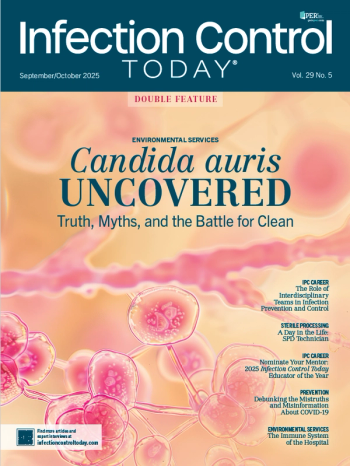
New Guidance Outlines Recommendations for Infection Control in Anesthesiology
By Kelly M. Pyrek
It is acknowledged that the operating room (OR) is a demanding environment in which to practice optimal infection prevention and control techniques, and new guidance points to the inconsistency with which practitioners observe policies.
"There are several challenges for anesthesia providers that complicate compliance with infection prevention and control practices," confirms Andrew Bowdle MD, PhD, FASE, professor of anesthesiology and pharmaceutics in the Department of Anesthesiology at the University of Washington in Seattle. "Anesthesia providers work in a fast-paced environment where there is usually great emphasis placed on efficiency, leaving little extra time for paying attention to infection control. The anesthesia workplace was never designed and constructed with infection control in mind, because our awareness of the impact of anesthesia infection control on hospital-acquired infection is relatively recent. Anesthesia providers have frequent, repeated contact with patients during an anesthetic. Studies have found that in many instances, following the WHO guidelines for hand hygiene would be virtually impossible in the anesthesia setting because providers would be constantly gelling and would have no time for anything else. The anesthesia workplace and anesthesia workflow has to be redesigned and adapted for infection control purposes."
Bowdle is second author of the new expert guidance produced by the Society for Healthcare Epidemiology of America (SHEA) which is designed to provide instruction on how hospitals and healthcare providers may reduce infections associated with anesthesiology procedures and equipment in the OR.
"The purpose of the SHEA expert guidance was to stimulate providers to think about these problems and to start the journey toward solving these problems," Bowdle adds.
The guidance, published in SHEA’s journal, Infection Control & Healthcare Epidemiology, recommends steps to improve infection prevention through increased hand hygiene, environmental disinfection, and continuous improvement plans, especially in the event of a lack of uniform institutional policy and procedures. The guidance was endorsed by the SHEA Board of Trustees, the American Academy of Anesthesiologist Assistants (AAAA), AANA, the Association for periOperative Registered Nurses (AORN), and APSF, with a letter of support from ASA.
As the guidance observes, "â¦infection prevention and control policies specific to anesthesia care in the OR are not universal; audits of infection prevention practices are not routine; and consequently, providers may not have clarity on expected practices and behaviors. Studies have reported problematic practices by anesthesia providers, including use of multiple-dose vials for>1 patient, <100% use of gloves for airway management, failure to perform hand hygiene (HH) after removing gloves, and entry into anesthesia cart drawers without performance of HH."
“Even though the demands on anesthesia providers make infection prevention best practices more challenging, there are opportunities for improvement,” says Silvia Munoz-Price, MD, PhD, lead author of the guidance and professor of medicine at Froedtert & Medical College of Wisconsin. “We describe how the anesthesiology team and hospital leaders can optimize infection prevention in operating room anesthesia, and we give suggestions for the future, including the need for better equipment design.”
A survey conducted by the SHEA Research Network (SRN) in 2016 documented that infection control policies and practices are inconsistent. Less than 36 percent of SRN respondents reported having infection prevention and control policies specific to anesthesia practice in the OR, with international respondents more likely than U.S. respondents to have such policies. For respondents answering that there were no policies specific to anesthesia, more than 97 percent reported the expectation that anesthesia provider practice in the OR would comply with institutional policies. Generally, facilities audited anesthesia providers’ infection prevention and control practices in the OR when there was a concern about practices (52.5 percent), although 22 percent of respondents reported a monthly audit. Only 6.8 percent of respondents never conducted audits.
In a 2017 SRN survey sent to members of ASA, AANA and AAAA, it was found that two-thirds of respondents reported having infection prevention and control guidelines specific for anesthesia services in their institution.
Alcohol-based hand rub (ABHR) was generally readily available within the anesthesia work area (always or usually: 93.8%) and was located at entry points to every OR (always or usually,92.3%). Respondents identified the following barriers to HH: lack of time in emergency situations (58.3%), lack of time in general (44.2%), skin factors (35.8%), HH equipment not easily accessible (27%), and lack of support from OR personnel for HH-related workflow interruptions (15.5%). Anesthesia providers identified several barrier precautions used for inserting central lines: mask (94.4%), sterile gloves (93.8%), gown (88%), cap (91.6%), and full drape (79.2%). The practice was different for placing arterial lines, with providers using all barrier elements less frequently: masks, 82%; sterile gloves, 74.2%; gown, 10.9%; cap, 76.8%; full drape, 3.7%). Almost half did not use a drape (48.1%). Institutions provided feedback variably on their departments’ adherence to HH (never, 40.9%; every 6â12 months, 34.9%; quarterly, 24.2%) and other infection prevention and control practices and procedures (never, 42.3%; every 6â12 months, 36.8%; quarterly, 20.9%).
The authors of the SHEA guidance emphasize that given the low response rate from anesthesia providers, it was difficult to determine how generalizable their findings are to all institutions and all anesthesia providers.
"The survey confirms that we have problems to solve but we really don’t have good data about what is happening in ORs nationwide," Bowdle says. "For example, in the first SHEA webinar following the release of the expert guidance, many participants indicated that they did not have hand gel inside of their operating rooms. This was somewhat of a surprise, to say the least, to the SHEA webinar panelists. We really have no idea how many operating rooms have hand gel and how many do not. Obviously, hand hygiene is a very fundamental infection prevention measure. We need to understand why some ORs do not have hand gel that is accessible to the anesthesia providers and figure out how to get hand gel into the anesthesia workplace. In all likelihood, there is wide variation between facilities, with some ORs having many good anesthesia infection prevention practices, and others not."
The SHEA guidance authors drew four conclusions from the survey results:
1. Infection prevention and control policies specific to anesthesia care in the OR are not universal in U.S. healthcare facilities.
2. Audits of infection prevention and control practices are not routine.
3. Not all anesthesia work areas are cleaned and disinfected between every patient, and the anesthesia cart is an item of risk for cross contamination.
4. Certain anesthesia-provider practices remain problematic, especially the use of multiple-dose vials for more than one patient, less than 100 percent use of gloves for airway management, lack of hand hygiene after removing gloves, and entry into anesthesia cart drawers without hand hygiene.
"Standardizing infection control practices relating to anesthesia will require the combined efforts of professional societies such as SHEA, ASA, and AANA," emphasizes Bowdle. "In addition, we need more much more scientific data about what infection prevention measures are most effective in the anesthesia setting. Standardization ultimately requires good evidence upon which to base standards. Enforcement is the role of state and local health authorities, hospital governance, Joint Commission, CMS and others. Again, enforcement is not reasonable without evidence-based standards.
The key recommendations from the SHEA guidance include:
-- Hand hygiene should be performed, at a minimum, before aseptic tasks, after removing gloves, when hands are soiled, before touching the anesthesia cart, and upon room entry and exit. The authors also suggest strategic placement of alcohol-based hand sanitizer dispensers.
As the guidance states, "Hand hygiene ideally should be performed according to the WHO 5 Moments for Hand Hygiene." The authors recommend that hand hygiene be performed at the minimum before aseptic tasks (e.g., inserting central venous catheters, inserting arterial catheters, drawing medications, spiking IV bags); after removing gloves; when hands are soiled or contaminated (e.g., oropharyngeal secretions); before touching the contents of the anesthesia cart; and when entering and exiting the OR (even after removing gloves).
-- During airway management, the authors suggest the use of double gloves so one layer can be removed when contamination is likely and the procedure moves too quickly to perform hand hygiene. The report also recommends high-level disinfection of reusable laryngoscope handles or adoption of single-use laryngoscopes.
As the guidance states, "To reduce risk of contamination in the OR, providers should consider wearing double gloves during airway management and should remove the outer gloves immediately after airway manipulation. As soon as possible, providers should remove the inner gloves and perform HH."
-- For environmental disinfection, the guidance recommends disinfecting high-touch surfaces on the anesthesia machines, as well as keyboards, monitors and other items in work areas in between surgeries, while also exploring the use of disposable covers and re-engineering of the work surfaces to facilitate quick decontamination in what is often a short window of time.
As the guidance states, "To reduce the bioburden of organisms and the risk of transmitting these organisms to patients, the facility should clean and disinfect high-touch surfaces on the anesthesia machine and anesthesia work area between OR uses with an EPA-approved hospital disinfectant that is compatible with the equipment and surfaces based on the manufacturer's instruction for use. Because of challenges in consistent cleaning and disinfection between cases of the anesthesia machine and anesthesia work area, the authors suggest prioritizing high-touch surfaces. In addition, the authors suggest evaluating strategies aimed at improving the ability to clean these surfaces (e.g., disposable covers, re-engineering of work surfaces)."
Note: In its environmental cleaning guidance in the 2019 Guidelines for Perioperative Practice, AORN recommends that anesthesia machines be cleaned and disinfected after every patient use. It also calls for terminal cleaning of the OR and all patient-care equipment, including anesthesia machines as well as anesthesia carts and equipment, including wheels and casters, as well as IV poles and IV pumps.
-- IV drug injection recommendations include using syringes and vials for only one patient; and that injection ports and vial stoppers should only be accessed after disinfection.
As the guidance states, " To reduce the risk of bacterial contamination of the syringe and syringe contents, the authors recommend that anesthesia providers cap needleless syringes that will be used to administer multiple doses of a drug to the same patient after each administered dose. Needleless syringes should be capped with a sterile cap that completely covers the Luer connector on the syringe."
The authors suggest that implementation of the recommendations requires multi-level collaboration within the hospital, regular monitoring, and evaluation of infection prevention practices with regular feedback for providers as well as clarity in expectations about behaviors. According to the guidance, leadership should define goals, remove barriers to infection prevention, and empower practitioners to meet standards.
The Role of IPs
Infection preventionists may have a role in improvement processes in the OR relating to audit work.
"When facilities implement measures for anesthesia infection prevention, it is important to attempt to measure the extent to which providers are actually able to carry out the desired behaviors and procedures," Bowdle says.
"This requires data collection (audits). Data collection requires hospital resources. Certainly, infection preventionists can help to provide resources for collecting data concerning implementation of infection prevention measures."
Infection preventionists also may become involved quality improvement efforts.
"The SHEA expert guidance is an excellent example of a cooperative effort between anesthesia providers, their professional societies, and infection preventionists," Bowdle adds. "This cooperative effort should be sought in individual facilities. Many infection preventionists have little or no experience with the anesthesia workplace, which is very different from most areas of the hospital. Most anesthesia providers have not thought deeply about the importance of infection prevention and how to achieve it. So, there is a lot of learning that needs to go on. Hopefully, the SHEA guidance will help to open minds to the need for a cooperative effort. As an anesthesia provider, I would recommend that infection preventionists who are not intimately familiar with the anesthesia workplace should start by reading the SHEA expert guidance, and then get into a scrub suit and spend some time simply watching what goes on."
ASA president Linda Mason, MD, FASA, says the collaboration between anesthesiology and infection prevention is critical to patient safety: “These guidelines address the evidence base for infection prevention while taking into account the realities of the operating room and the complexities involved in providing anesthesia services.”
ASA says it supports local hospital-level discussions and decision-making regarding the use of laryngoscopes, including disinfection procedures per the manufacturer’s recommendations or use of disposable tools, and emphasizes that practices and local administrators should follow any and all updates to the U.S. Pharmacopeia Chapter <797>, expected in the coming months.
Unresolved Issues
The SHEA guidance acknowledges several unique elements of anesthesia practice that pose unsolved problems for infection prevention, including the anesthesia machine, the anesthesia cart, and provider-prepared drugs and IV infusion bags. As the authors explain, "Numerous challenges exist for thorough cleaning of the anesthesia machine between cases. The anesthesia machine is a complicated apparatus with an irregular and complex external surface. Many anesthesia machines also have drawers to store supplies. Anesthesia machines were designed at a time when the importance of infection prevention in the anesthesia workplace was not well understood, and since then, the fundamental design has not changed greatly. The anesthesia machine may need to undergo fundamental redesign that allows for quick and effective cleaning of the external surfaces."
The authors continue, "The anesthesia supply cart presents similar challenges and cleaning the anesthesia cart between cases can be extremely challenging depending upon the particular design of the cart. Anesthesia carts have many variations, which also can have a complex exterior surface due to attachment of electrical components such as a defibrillator or cardiac output monitor, sharps collection containers, waste bins, and discarded drug collection containers. Supplies and materials may be stored in cart drawers but also in bins on the top of the cart. Typical anesthesia carts contain supplies and materials intended to be used for numerous cases. Contamination of supplies can occur if providers do not remove soiled exam gloves and apply ABHR prior to obtaining supplies and materials from storage. Few examples exist of practices that have attempted to include the anesthesia cart in a clean zone, where only clean hands are allowed. Although some success has been documented with this approach, maintaining the desired provider behavior presents challenges."
"As noted in the SHEA expert guidance, cleaning and disinfecting the anesthesia workplace is very challenging because of the physical complexity of the equipment and the minimal time available for cleaning between patients," Bowdle says. "The strategic use of single-use materials (example-single-use laryngoscopes, blood pressure cuffs, pulse oximeter sensors, ECG lead wires) and disposable plastic covers for reusable equipment (example-parts of the anesthesia machine, keyboards, touch screens) should be strongly considered. Cleaning of all uncovered surfaces of the anesthesia machine and anesthesia cart between cases may be impossible in the available time, and if so, cleaning should focus on high-touch areas.
Reference: Munoz-Price S, Bowdle A, Johnston BL, Bearman GM, Camins BC, Dellinger EP, Geisz-Everson MA, Holzmann-Pazgal G, Murthy R, Pegues D, Prielipp RC, Rubin ZA, Schaffzin J, Yokoe D and Birnbach DJ. SHEA Expert Guidance: Infection Prevention in the Operating Room Anesthesia Work Area. Web (Dec. 11, 2018).
Newsletter
Stay prepared and protected with Infection Control Today's newsletter, delivering essential updates, best practices, and expert insights for infection preventionists.






